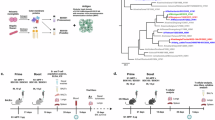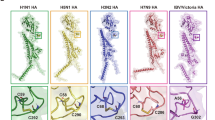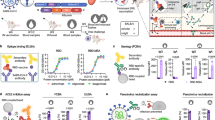Abstract
The oral cavity is an accessible site for vaccination, but its sublingual and buccal sites have limited vaccine uptake. Here we show that flat tape dental floss can deliver vaccines through the junctional epithelium of the gingival sulcus, exploiting its naturally leaky properties. Floss-based vaccination delivered protein, inactivated virus, peptide-presenting immunogenic nanoparticles and messenger RNA. In mice, gold nanoparticles functionalized with a peptide derived from the ectodomain of the transmembrane matrix 2 protein of human influenza virus stimulated local lymph nodes, increased CD4+T cells in lymph nodes, lungs and spleen, and boosted antibody-secreting cells in the bone marrow. Floss-based immunization induced strong and sustained immune activation across multiple organs, robust systemic and mucosal antibody responses, and durable protection against lethal influenza infection, independent of age, food and liquid consumption. Floss-based vaccination was superior to sublingual and comparable with intranasal vaccination. In human participants, fluorescent dye delivered via floss picks effectively reached gingival sulcus, supporting clinical feasibility. These findings establish floss-based vaccination as a simple, needle-free strategy that enhances vaccine delivery and immune activation compared with existing mucosal immunization methods.
This is a preview of subscription content, access via your institution
Access options
Access Nature and 54 other Nature Portfolio journals
Get Nature+, our best-value online-access subscription
$32.99 / 30 days
cancel any time
Subscribe to this journal
Receive 12 digital issues and online access to articles
$119.00 per year
only $9.92 per issue
Buy this article
- Purchase on SpringerLink
- Instant access to full article PDF
Prices may be subject to local taxes which are calculated during checkout








Similar content being viewed by others
Data availability
All data that support the claims of this study are available in this article or its Extended Data and Supplementary Information. Source data are provided with this paper. For additional information, please contact the corresponding author at hsgill2@ncsu.edu.
References
Shakya, A. K., Chowdhury, M. Y. E., Tao, W. & Gill, H. S. Mucosal vaccine delivery: current state and a pediatric perspective. J. Control. Release 240, 394–413 (2016).
Alsbrooks, K. & Hoerauf, K. Prevalence, causes, impacts, and management of needle phobia: an international survey of a general adult population. PLoS ONE 17, e0276814 (2022).
Deuchert, E. & Brody, S. Lack of autodisable syringe use and health care indicators are associated with high HIV prevalence: an international ecologic analysis. Ann. Epidemiol. 17, 199–207 (2007).
Lycke, N. Recent progress in mucosal vaccine development: potential and limitations. Nat. Rev. Immunol. 12, 592–605 (2012).
Azzi, L. et al. Mucosal immune response in BNT162b2 COVID-19 vaccine recipients. eBioMedicine 75, 103788 (2022).
Kraan, H. et al. Buccal and sublingual vaccine delivery. J. Control. Release 190, 580–592 (2014).
Song, J.-H. et al. Sublingual vaccination with influenza virus protects mice against lethal viral infection. Proc. Natl Acad. Sci. USA 105, 1644–1649 (2008).
McGhee, J. R. & Fujihashi, K. Inside the mucosal immune system. PLoS Biol. 10, e1001397 (2012).
Neutra, M. R. & Kozlowski, P. A. Mucosal vaccines: the promise and the challenge. Nat. Rev. Immunol. 6, 148–158 (2006).
Paris, A. L., Colomb, E., Verrier, B., Anjuère, F. & Monge, C. Sublingual vaccination and delivery systems. J. Control. Release 332, 553–562 (2021).
Mokabari, K., Iriti, M. & Varoni, E. M. Mucoadhesive vaccine delivery systems for the oral mucosa. J. Dent. Res. 102, 709–718 (2023).
Shimono, M. et al. Biological characteristics of the junctional epithelium. J. Electron Microsc. 52, 627–639 (2003).
Bosshardt, D. D. & Lang, N. P. The junctional epithelium: from health to disease. J. Dent. Res. 84, 9–20 (2005).
Luke, D. A. The structure and functions of the dentogingival junction and periodontal ligament. Br. Dent. J. 172, 187–190 (1992).
Stern, I. B. Current concepts of the dentogingival junction: the epithelial and connective tissue attachments to the tooth. J. Periodontol. 52, 465–476 (1981).
Oh, C., Kim, H. J. & Kim, H. M. Transepithelial channels for leukocytes in the junctional epithelium. J. Periodontal Res. 57, 1093–1100 (2022).
Dutzan, N., Konkel, J. E., Greenwell-Wild, T. & Moutsopoulos, N. M. Characterization of the human immune cell network at the gingival barrier. Mucosal Immunol. 9, 1163–1172 (2016).
Boese, S. & Gill, H. S. Coated floss for drug delivery into the gum pocket. Int. J. Pharm. 606, 120855 (2021).
Subbarao, K. C. et al. Gingival crevicular fluid: an overview. J. Pharm. Bioallied Sci. 11, S135–S139 (2019).
Galli, S. J. & Tsai, M. IgE and mast cells in allergic disease. Nat. Med. 18, 693–704 (2012).
Ainai, A., Suzuki, T., Tamura, S. I. & Hasegawa, H. Intranasal administration of whole inactivated influenza virus vaccine as a promising influenza vaccine candidate. Viral Immunol. 30, 451–462 (2017).
Seasonal flu vaccines. Centers for Disease Control and Prevention https://www.cdc.gov/flu/vaccines/keyfacts.html (2024).
Gresset-Bourgeois, V. et al. Quadrivalent inactivated influenza vaccine (VaxigripTetra™). Exp. Rev. Vaccines 17, 1–11 (2018).
Haugh, M., Gresset-Bourgeois, V., Macabeo, B., Woods, A. & Samson, S. I. A trivalent, inactivated influenza vaccine (Vaxigrip®): summary of almost 50 years of experience and more than 1.8 billion doses distributed in over 120 countries. Exp. Rev. Vaccines 16, 545–564 (2017).
Murdin, A. D., Barreto, L. & Plotkin, S. Inactivated poliovirus vaccine: past and present experience. Vaccine 14, 735–746 (1996).
Tao, Y. Y. et al. Quadrivalent influenza vaccine (Sinovac Biotech) for seasonal influenza prophylaxis. Exp. Rev. Vaccines 20, 1–11 (2021).
Vaccines licensed for use in the United States. US Food and Drug Administration https://www.fda.gov/vaccines-blood-biologics/vaccines/vaccines-licensed-use-united-states (2023).
Estrada, L. D. & Schultz-Cherry, S. Development of a universal influenza vaccine. J. Imunol. 202, 392–398 (2019).
Sautto, G. A., Kirchenbaum, G. A. & Ross, T. M. Towards a universal influenza vaccine: different approaches for one goal. Virol. J. 15, 17 (2018).
Pica, N. & Palese, P. Toward a universal influenza virus vaccine: prospects and challenges. Ann. Rev. Med. 64, 189–202 (2013).
Taubenberger, J. K. & Morens, D. M. 1918 Influenza: the mother of all pandemics. Emerg. Infect. Dis. 12, 15–22 (2006).
Wang, W. C., Sayedahmed, E. E., Sambhara, S. & Mittal, S. K. Progress towards the development of a universal influenza vaccine. Viruses https://doi.org/10.3390/v14081684 (2022).
Tao, W., Ziemer, K. S. & Gill, H. S. Gold nanoparticle-M2e conjugate coformulated with CpG induces protective immunity against influenza A virus. Nanomedicine 9, 237–251 (2014).
Tao, W. et al. Consensus M2e peptide conjugated to gold nanoparticles confers protection against H1N1, H3N2 and H5N1 influenza A viruses. Antivir. Res. 141, 62–72 (2017).
Ingrole, R. S. J., Tao, W., Joshi, G. & Gill, H. S. M2e conjugated gold nanoparticle influenza vaccine displays thermal stability at elevated temperatures and confers protection to ferrets. Vaccine 39, 4800–4809 (2021).
Sjökvist Ottsjö, L. et al. Induction of mucosal immune responses against Helicobacter pylori infection after sublingual and intragastric route of immunization. Immunology 150, 172–183 (2017).
Liao, S. & von der Weid, P. Y. Lymphatic system: an active pathway for immune protection. Semin. Cell Dev. Biol. 38, 83–89 (2015).
Reichel, C. A. et al. Ccl2 and Ccl3 mediate neutrophil recruitment via induction of protein synthesis and generation of lipid mediators. Arterioscler. Thromb. Vasc. Biol. 29, 1787–1793 (2009).
Tanaka, T., Narazaki, M. & Kishimoto, T. IL-6 in inflammation, immunity, and disease. Cold Spring Harb. Perspect. Biol. 6, a016295 (2014).
Trinchieri, G. Interleukin-12: a proinflammatory cytokine with immunoregulatory functions that bridge innate resistance and antigen-specific adaptive immunity. Ann. Rev. Immunol. 13, 251–276 (1995).
Liang, C. K. et al. COVID-19 vaccines in older adults: challenges in vaccine development and policy making. Clin. Geriatr. Med. 38, 605–620 (2022).
Baldwin, S. L. et al. Improved immune responses in young and aged mice with adjuvanted vaccines against H1N1 influenza infection. Front. Immunol. 9, 295 (2018).
García, M., Misplon, J. A., Price, G. E., Lo, C.-Y. & Epstein, S. L. Age dependence of immunity induced by a candidate universal influenza vaccine in mice. PLoS ONE 11, e0153195 (2016).
Kim, K.-H. et al. Immunogenicity and neutralizing activity comparison of SARS-CoV-2 spike full-length and subunit domain proteins in young adult and old-aged mice. Vaccines 9, 316 (2021).
Bang, Y. J. et al. Effective inactivated influenza vaccine for the elderly using a single-stranded RNA-based adjuvant. Sci. Rep. 11, 11981 (2021).
Baldo, V. et al. Immunogenicity of three different influenza vaccines against homologous and heterologous strains in nursing home elderly residents. Clin. Dev. Immunol. 2010, 517198 (2010).
DiazGranados, C. A. et al. Efficacy of high-dose versus standard-dose influenza vaccine in older adults. New Engl. J. Med. 371, 635–645 (2014).
Chahine, E. B. High-dose inactivated influenza vaccine quadrivalent for older adults. Ann. Pharmacother. 55, 89–97 (2021).
Mohan, T. et al. Chimeric virus-like particles containing influenza HA antigen and GPI-CCL28 induce long-lasting mucosal immunity against H3N2 viruses. Sci. Rep. 7, 40226 (2017).
Keller, L.-A., Merkel, O. & Popp, A. Intranasal drug delivery: opportunities and toxicologic challenges during drug development. Drug Deliv. Transl. Res. 12, 735–757 (2022).
Mutsch, M. et al. Use of the inactivated intranasal influenza vaccine and the risk of Bell’s palsy in Switzerland. New Engl. J. Med. 350, 896–903 (2004).
Boese, S. & Gill, H. S. Drug-coated floss to treat gum diseases: in vitro and in vivo characterization. ACS Appl. Mater. Interfaces 14, 28663–28670 (2022).
Chen, Y., Mutukuri, T. T., Wilson, N. E. & Zhou, Q. T. Pharmaceutical protein solids: drying technology, solid-state characterization and stability. Adv. Drug Deliv. Rev. 172, 211–233 (2021).
Amorij, J. P., Huckriede, A., Wilschut, J., Frijlink, H. W. & Hinrichs, W. L. Development of stable influenza vaccine powder formulations: challenges and possibilities. Pharm. Res. 25, 1256–1273 (2008).
Chu, L. Y. et al. Enhanced stability of inactivated influenza vaccine encapsulated in dissolving microneedle patches. Pharm. Res. 33, 868–878 (2016).
Teeth development in children. Better Health Channel https://www.betterhealth.vic.gov.au/health/conditionsandtreatments/teeth-development-in-children#rpl-skip-link (2021).
Kraan, H., Soema, P., Amorij, J.-P. & Kersten, G. Intranasal and sublingual delivery of inactivated polio vaccine. Vaccine 35, 2647–2653 (2017).
Tiwari, M. et al. Assessment of immunogenic potential of Vero adapted formalin inactivated vaccine derived from novel ECSA genotype of Chikungunya virus. Vaccine 27, 2513–2522 (2009).
Uddin, M. J. & Gill, H. S. From allergen to oral vaccine carrier: a new face of ragweed pollen. Int. J. Pharm. 545, 286–294 (2018).
Acknowledgements
We acknowledge the support provided by the National Institutes of Health. H.S.G. discloses support for the research described in this study from the National Institutes of Health (grant no. R01AI137846), the National Institutes of Health (grant no. R01DE033759) and the Whitacre Endowed Chair in Science and Engineering. The content is solely the responsibility of the authors and does not necessarily represent the official views of the National Institutes of Health. We also thank C. Roseburd Magezi Ndamira, a graduate student of Gill lab at TTU, for her help in capturing Supplementary Movie 1.
Author information
Authors and Affiliations
Contributions
Conceptualization: R.S.J.I., A.K.S. and H.S.G. Methodology: R.S.J.I., A.K.S. and H.S.G. Investigation: R.S.J.I., A.K.S. and H.S.G. Human studies: R.S.J.I. Data analysis: R.S.J.I. and H.S.G. Creation of figures: R.S.J.I. and H.S.G. Funding acquisition: H.S.G. Project administration: H.S.G. Supervision: H.S.G. Writing—original draft: R.S.J.I. and H.S.G. Writing—review and editing: R.S.J.I., R.W.C. and H.S.G. G.J. prepared the influenza virus stocks used for challenge and for Inac. virus study. C.H.L. helped with design of the primers used for qRT–PCR study and in analysis of the qRT–PCR data. L.D.N. helped with design and analysis of flow cytometry experiment.
Corresponding author
Ethics declarations
Competing interests
H.S.G., R.S.J.I. and A.K.S. are coinventors on a patent related to targeting the JE for vaccination and allergen immunotherapy. H.S.G. and R.S.J.I. are coinventors on a patent related to the pipette-based coating of floss. A startup company is pursuing this technology. This startup company has licensed the patent related to targeting the JE for vaccination and allergen immunotherapy. R.S.J.I. has equity in this company. R.S.J.I. has joined this company by the time the revised version of the paper was submitted. However, findings in this article were not influenced by the company. This potential competing interest has been disclosed and is being managed by TTU. No part of this study was paid for by the company nor was the company involved in any data interpretation or analysis. The other authors declare no competing interests.
Peer review
Peer review information
Nature Biomedical Engineering thanks the anonymous reviewers for their contribution to the peer review of this work.
Additional information
Publisher’s note Springer Nature remains neutral with regard to jurisdictional claims in published maps and institutional affiliations.
Extended data
Extended Data Fig. 1 Flossing procedure ex-vivo.
a, Brightfield stereoscopic image of the jaw tissue of naïve mice (top panel) and the jaw tissue after placing flat tape floss between the bottom two incisors (bottom two panels). The floss rested in the cavity without damaging the surrounding muscle tissue.
Extended Data Fig. 2 IVIS-based temporal tracking and quantification of material delivered to the JE.
Mice were treated with Alexa660-tagged Ova, either coated on floss or administered in a drop-wise manner. Untreated (Naïve) mice were used as the negative control. All mice were provided ad libitum access to food and water post-treatment. IVIS images of naïve mice (a). IVIS images showing retention of Alexa660-tagged Ova at the delivery site in mice treated in a drop-wise manner (b) or treated with coated floss (c).
Extended Data Fig. 3 Ex-vivo temporal tracking and quantification of material delivered to the JE.
Rhodamine-tagged Ova was delivered to the gingival sulcus either using a coated floss or drop placement. At different time points, tissue was excised, washed, and imaged using a stereomicroscope. a, Brightfield and fluorescence images for flossed mice. b, Brightfield and fluorescent images for mice receiving a liquid drop.
Extended Data Fig. 4 Recall antibody response post-challenge in mice vaccinated with inactivated virus coated on the floss.
Mice were immunized with either 10 µg or 25 µg of Inac. A/Puerto Rico/8/34 virus (PR8) influenza virus coated on floss. Mice either received two or three immunizations. UnVacc. mice were used as a negative control. On day 57, mice including the UnVacc. group were challenged with 3×LD50 of influenza A PR8 virus. On day 4 post-challenge, different mucosal secretions such as fecal pellets, vaginal wash, and saliva were collected from mice. Mice were then euthanized, and LL and NW were collected from euthanized mice. Anti-Inac. virus specific IgG and IgA in fecal pellets (a), vaginal wash (b), and saliva (c). Anti-Inac. virus specific IgG in LL (d), and NW (e) of immunized (floss) or UnVacc. mice. Data are presented as the arithmetic mean ± SD of samples from individual animals. N = 4 to 5 mice in each group. The Mann–Whitney Unpaired test (two-tailed) was used to calculate p values for differences between groups.
Extended Data Fig. 5 Recall antibody response post-challenge in mice vaccinated with M2e-AuNP + CpG.
Mice were vaccinated on day 0 and day 21 with M2e-AuNP+CpG (1X) vaccine formulation either coated on floss or administered IN. UnVacc. mice were used as negative controls. On day 43, mice were challenged with 3×LD50 of influenza A H1N1pdm09 virus. On day 4 post-challenge, different mucosal secretions, such as vaginal wash and saliva, were collected from the mice. Mice were then euthanized, and LL and NW were collected from euthanized mice. Anti-M2e IgG and IgA in vaginal wash (a), and saliva (b), LL (c), and NW (d) of immunized (floss/ IN) or UnVacc. mice. N = 3 to 5 mice in each group. Data are presented as the arithmetic mean ± SD of samples from individual animals. The Mann–Whitney Unpaired test (two-tailed) was used to calculate p values for differences between groups.
Supplementary information
Supplementary Information
Supplementary figures and tables.
Supplementary Movie 1
Floss coated with rhodamine-tagged Ova for flossing mice incisors ex vivo.
Supplementary Movie 2
Demonstration of flossing mice incisors, ex vivo, with rhodamine-tagged Ova.
Supplementary Movie 3
Demonstration of flossing in human and deposition of coatings in gingival sulcus.
Source data
Source Data Figs. 1–8 and Extended Data Figs. 4 and 5
For Fig. 1: FIG_1, FIG_2, FIG_3, FIG_4, FIG_5, FIG_6, FIG_7 and FIG_8. For extended data: ED_FIG4, ED_FIG5, Supplementary Fig. 1, Supplementary Fig. 2, Supplementary Fig. 3, Supplementary Fig. 4 and Supplementary Fig. 5.
Rights and permissions
Springer Nature or its licensor (e.g. a society or other partner) holds exclusive rights to this article under a publishing agreement with the author(s) or other rightsholder(s); author self-archiving of the accepted manuscript version of this article is solely governed by the terms of such publishing agreement and applicable law.
About this article
Cite this article
Ingrole, R.S.J., Shakya, A.K., Joshi, G. et al. Floss-based vaccination targets the gingival sulcus for mucosal and systemic immunization. Nat. Biomed. Eng (2025). https://doi.org/10.1038/s41551-025-01451-3
Received:
Accepted:
Published:
DOI: https://doi.org/10.1038/s41551-025-01451-3
This article is cited by
-
Floss-based vaccination
Nature Reviews Bioengineering (2025)



